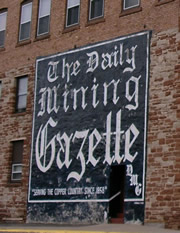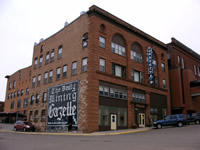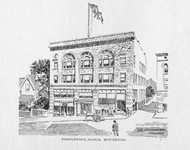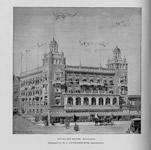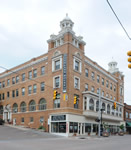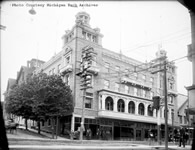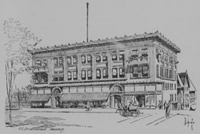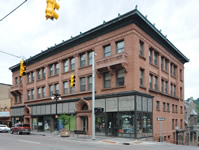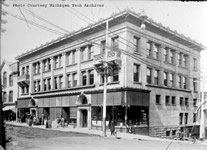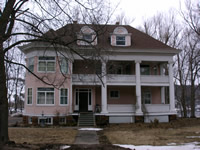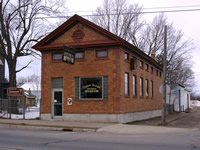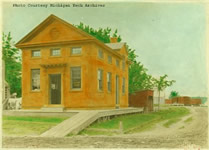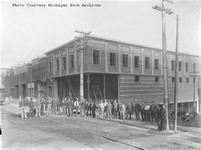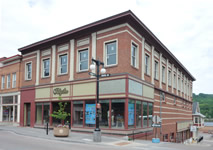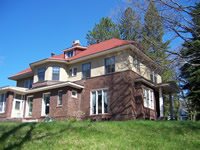James R. Dee Block (Post Office Block) The James R. Dee Block is located in downtown Houghton close to the Shelden-Dee Block and the Douglass House. James R. Dee started the telephone business in the Houghton-Hancock area, and brought electricity to the area through the Peninsula Electric and Light Company.6 As the demand for electricity increased, Dee needed a new place of business. To accomplish this, he hired Ottenheimer to design the James R. Dee Block that would be home to his electric company.7 The Daily Mining Gazette and the post office were also located in the building. In 1980 the building was converted to apartments and is currently called the Gazette Apartments. The four-story building, built into the hillside, has a rough-faced Jacobsville sandstone front. Two-story pilasters define the entrance, which is flanked by large windows that have been partially filled in. The third and fourth floors are united in large round arches, with roundels in the corners of the façade. The façade is topped with a modillioned cornice. A painted sign advertising the Daily Mining Gazette remains on the north side.
Douglass House The original Douglass House was built in 1860 out of wood and set back from Shelden Avenue, on Montezuma, with a terraced garden stretching to Shelden. Ottenheimer was asked to design an addition to the Douglass House that would be grand enough to welcome the important businessmen of the mines. The design extended the Douglass House to the edge of Shelden and doubled the hotel capacity from fifty to one hundred rooms. Today the building incorporates a bar and restaurant on street level, and the hotel rooms have been renovated to accommodate senior citizens. The buff-brick building has white-glazed terra cotta trim. The distinctive corner Baroque corner towers do not appear on Ottenheimer’s drawings and were probably added during construction.8 A seven-bay-wide balcony extends across the front at the second-floor level. This"loggia," along with the gold-colored cupolas, were said to lend a "picturesque and oriental" air.9 An elaborate entrance to the hotel portion is on the east side, while the north front is devoted to storefronts. In 1901 the hotel suffered a devastating fire, which broke out in the rear, frame portion. The back portion was built of brick to match the new front. The newspaper described the hotel on the eve of its opening on August 4, 1900. The first floor, facing onto Shelden Avenue,, held the bar, billiard rooms, and railroad ticketing offices. The main entrance was on the side, on Isle Royale Street. The general reception or reading room featured a tile mosaic floor, paneled wainscoting of quarter-sawn oak, a marble baseboard, dark-colored burlap on the walls, a light-colored frieze, and gold stenciling on the ceiling. A large chimney piece of dark-colored wood had Ionic columns; above the fireplace was a large moose head.10 Ladies had their own separate entrance and parlor, “so that any woman can enter the apartment and by touching a bell, gain any of the conveniences of the hotel without being required to show herself in the hotel office.” The main dining room, measuring 55 by 30 feet, had wood paneling extending 6 feet high, painted with a white enamel finish. The kitchen was illuminated by two skylights. Nearby, occupying the space of the former bar was a sample room, “furnished with wide tables where traveling men can display their goods to prospective customers.” The guest bedrooms were kalsomined in two colors. There were eleven private bathrooms and two public lavatories.11 The $100,000 building was heralded as “the finest hotel in the Upper Peninsula” and it promised to make Houghton “the Mecca of the entire traveling and tourist fraternity.” John C. Mann, the proprietor, was apparently lured to Houghton from Ashland, where he was famous for his planked whitefish.12
Shelden-Dee Block Located directly north of the Douglass House, the Shelden-Dee block was commissioned by James R. Dee and Mary Shelden in the late 1890s. The building provided elegant commercial and office space in Houghton's booming downtown. The building is faced with Portage Entry sandstone. Three stories tall, the building measures 100' on Sheldon and 70' on Isle Royale St. Two-story pilasters divide the bays on the two upper stories; windows are paired in each bay. The end bays have stone balconies between the second and third floors. There are two round-arched stone entrances at ground level. In between, the store windows are mostly intact, with transom windows of Luxfer prism lights. The flat-roofed building has a copper cornice with deep overhang. The four commercial spaces were originally occupied by (beginning on the corner) a drug store, a shoe store, a dry goods store, and a café and saloon, with a barber in the basement. Office suites were located on the upper floors. The newspaper noted that "the building will be equipped throughout with all the latest devices of a modern building and will be one of the finest in finish and construction in the Upper Peninsula." Its estimated cost of construction was $75,000.13 Businesses still occupy the street-level floor but the offices have been converted into apartments.
Allen Rees House Allen Rees, a prominent lawyer, employed Ottenheimer to design his asymmetrical Classical Revival-style house. The two-and-a-half-story house has two-story Ionic columns and a squat two-story corner tower. The broad hip roof extends to cover the portico. Round-arched dormer windows punctuate the roofline. The frame house, covered with clapboards, sits above a Jacobsville sandstone foundation. The house stayed in the Rees family for 62 years, until it was purchased by Larry and Rosemary Remington. The third owners were John and Helen Sullivan who operated a bed and breakfast inn here, before selling the building Lambda Chi Alpha fraternity in 2005. South Range Bank (Copper Range Historical Museum) The South Range Bank was founded by a group of men that included Nathan Leopold and Allan Rees, both of whom employed Ottenheimer to design other buildings in the U.P.14 Since 1993, the building has been home to the Copper Range Historical Museum. The bank was designed in the Classical Revival style, with a pedimented gable front and a denticulated cornice. The orange-ish brick is trimmed with smooth-faced sandstone. There are attic windows below the cornice. On the side walls, the windows have splayed lintels and keystones. Originally, the entrance was in the center bay, topped with a bracketed and modillioned hoodmold. The entrance was changed to the present configuration in 1905, when a plate-glass window was installed.15 Inside, a large open space accommodated the bank’s windows and cages. Behind this room were the office and stairs to the second floor and basement. The second floor held living quarters or offices.16
Leopold Building The Leopold Building was developed for Nathan Leopold, one of the founders of the South Range State Bank. The newspaper described the building: “The building ranks with the finest business blocks in Houghton or the copper country.” It was occupied by a department store on the Shelden Street side and a bar on the Huron Street side, with offices on the second floor.17 The building, according to the plans, was rectangular in shape, two stories tall and five bays wide.18 The building is red brick with white-glazed brick trim. Pilasters separate the windows on the second floor. On the front, the end bays are differentiated, with a cornice-like white trim, and the three center bays have white panels over the windows. On the Huron Street side, white stripes in the brick decorate the first-floor wall.
Harris House The Harris House was constructed for Samuel B. Harris and his son, John Harris.19 Cornish-born Samuel Harris was superintendent of the Quincy mine from 1884-1902 and was succeeded, briefly, by his college-educated son, John. The two men shared the house. The building is located on the top of a bluff that overlooks the Portage Canal, and sits on a large plot, whereas the surrounding buildings were constructed very close to one another. The house shows some Prairie-style influences in its broad roof, low profile, and overhanging eaves. The first floor is brick, while the second story is finished in a contrasting stucco. The plan is very asymmetrical, especially the offset hall, with rooms flowing from one to the other.20
|
